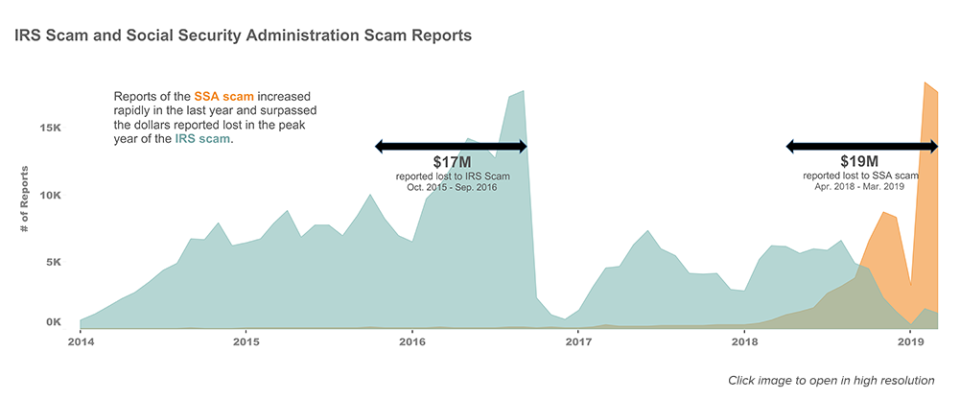Social Security phone scams are now a greater threat than IRS scams

Since October 2013, IRS phone scams have cost around 14,700 people more than $72 million in wire transfers, gift cards, and prepaid debit cards. The standard operating procedure: threatening immediate arrest by law enforcement unless the person pays — and quickly.
Historically, IRS scams have been the most common phone tactic used by scammers. But in the first six months of 2019, scammers are favoring a new method which involves getting victims’ Social Security information.
According to FTC complaint data, as well as data from background check provider BeenVerified, Social Security scam reports have increased by 23 times in the first six months of the year.
This problem is new and growing. BeenVerified’s data show that in 2018, Social Security scam calls made up only 1.5% of total spam call comments and IRS and tax scams made up 6.8%. But this year, Social Security shot up to 9.5% of complaints as IRS scams fell to 1.7%.
FTC data bears this out as well. Over the past year and a half, FTC reports for Social Security scam calls have ballooned, with over 76,000 in a 12-month period, with losses coming to $19 million. This is worse than the worst year of IRS scams, which recorded $17 million in scams, according to the agency in 2016.
In April, the FTC said that $6.7 million in reported losses were recorded in the previous two months, with the scam hitting all age groups. Like the IRS scam, people pay in gift cards, but other forms like bitcoin and feeding cash into bitcoin ATMs have been another method in getting anonymous cash to scammers.
The tactics are somewhat similar to the IRS scam. Scammers often try to scare consumers into paying quickly using made-up lawsuits, quoting badge numbers and using official language.
An example complaint from the background check service: “This message is from the legal department of the Social Security Administration. My federal badge ID is SSA 456. The purpose of this call is regarding an enforcement action, which has been executed by the U.S. Treasury against your Social Security number.”
BeenVerified’s data highlighted another tactic: luring consumers with prizes and free offers like cruises, hotels, gift cards, and iPhones.

BeenVerified noted that the situation is probably much worse, given the data is self-reported. Only those who chose to report the calls are counted.
Though only 3.4% of people who report a scam actually get scammed — most just call to say their Social Security number got stolen — it’s pretty bad when it happens. The median amount of damages is $1,500, which is “four times higher than the median individual loss for all frauds,” according to the FTC.
The data highlights the ongoing nature of the scam industry, which operates in a Darwinian atmosphere. As the climate changes — people become educated about scams — the tactics change and scammers concentrate on what works.
Stopping robocalls is a key step
Today more people understand that the IRS won’t ever call you and demand immediate payment (this is the same for the Social Security Administration, and SSNs do not get “suspended”. The agency has taken great pains to educate the public, and those steps appear to have worked, as the amount of grift has tapered off. But now with the focus turning to Social Security numbers, the need for a more comprehensive solution is higher.
A key problem? Many of these scam calls begin with robocalls.
The anti-robocall provisions set up by phone companies are helping, and the implementation of STIR/SHAKEN, the authentication standard expected to combat robocalls and faking caller ID numbers should help.
But as data from telecom analytics firm Transaction Network Services (TNS) notes, the problem is far from over.
“Things aren’t getting better,” said Jim Tyrrell, senior director of product marketing at TNS. “Nuisance and high-risk calls are increasing [by] double-digits.”
For Social Security scams the problem is even worse, because it goes after older people who depend on Social Security benefits for income, and according to new survey data from TNS, there’s a vast demographic difference between the people who choose to take advantage of robocall blocking services offered by companies and those who don’t.
While only 39% of the TNS survey respondents said they’d be open to automatic call blocking, nearly half of people age 25 to 34 would be fine with blocking all numbers not on a person’s contact list; 69% of total respondents said they’d like lower-risk calls to be sent to voicemail.
TNS data from September found that Americans receive 200 million unwanted robocalls per day, with 12% coming from the top six U.S. carriers (AT&T, CenturyLink, Comcast, Sprint, T-Mobile and Verizon, Yahoo Finance’s parent company), despite 70% of overall call volume coming from these top carriers. The implication here is that the larger carriers are doing a good job stopping robocalls, while smaller regional carriers and voice-over-IP providers need to improve. Sources in the telecom industry say some smaller phone companies actively turn a blind eye to robocallers and scammers, as it’s good for their business.
One interesting development, according to TNS, is that while VoIP spoofing has dropped, robocalls from toll-free numbers doubled from 12% to 25%. This presents a new challenge to brands that use these legitimate numbers.
“Sophisticated spammers are now spoofing calls over several telephone numbers in low volume, and then rapidly churning through them to evade detection,” said Tyrell. “This tactic is known as ‘snowshoe spamming,’ a form of neighbor spoofing.”
For now, at least, there is good news from TNS.
“I would expect [robocalls] to improve later this year as STIR/SHAKEN starts to get deployed,” said Tyrrell. “And even more so in 2020 as call authentication becomes more widely prevalent.”
-
Ethan Wolff-Mann is a writer at Yahoo Finance focusing on consumer issues, personal finance, retail, airlines, and more. He is reporting from Berlin on the Arthur F. Burns fellowship from the International Center for Journalists. Follow him on Twitter @ewolffmann.
Beyond Meat is learning a big lesson in Germany
Rising oil prices are both good and bad for the US economy
Americans are trying to invest in Denmark’s negative mortgages
‘Flight shame’: A potential headwind for airlines in Europe
Apple Card might finally get people to use Apple Pay
Read the latest financial and business news from Yahoo Finance
Follow Yahoo Finance on Twitter, Facebook, Instagram, Flipboard, LinkedIn, YouTube, and reddit.
